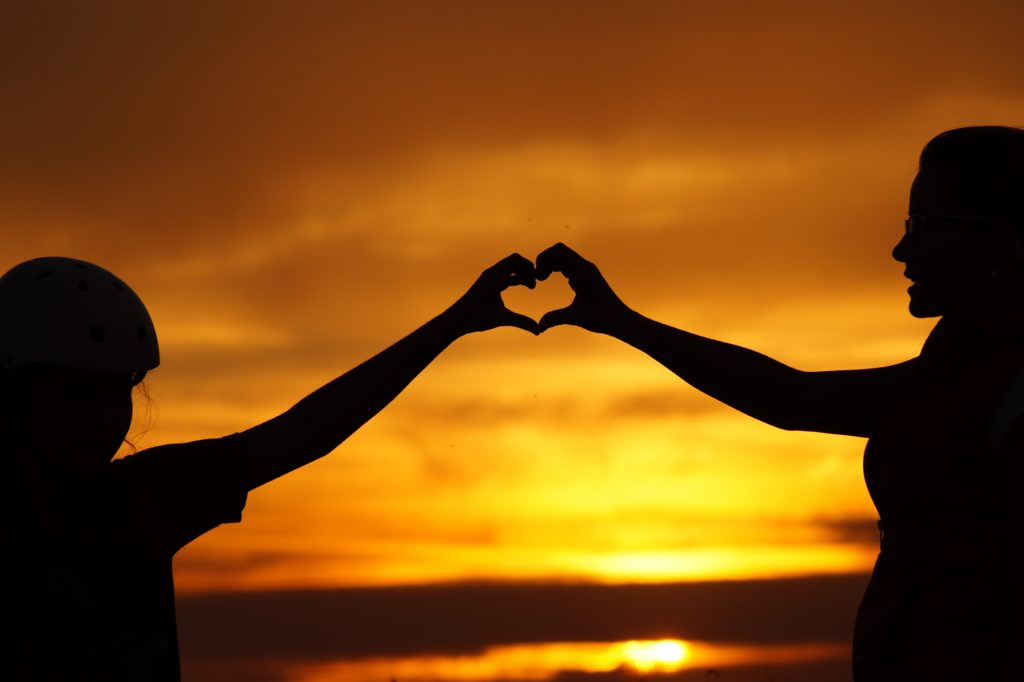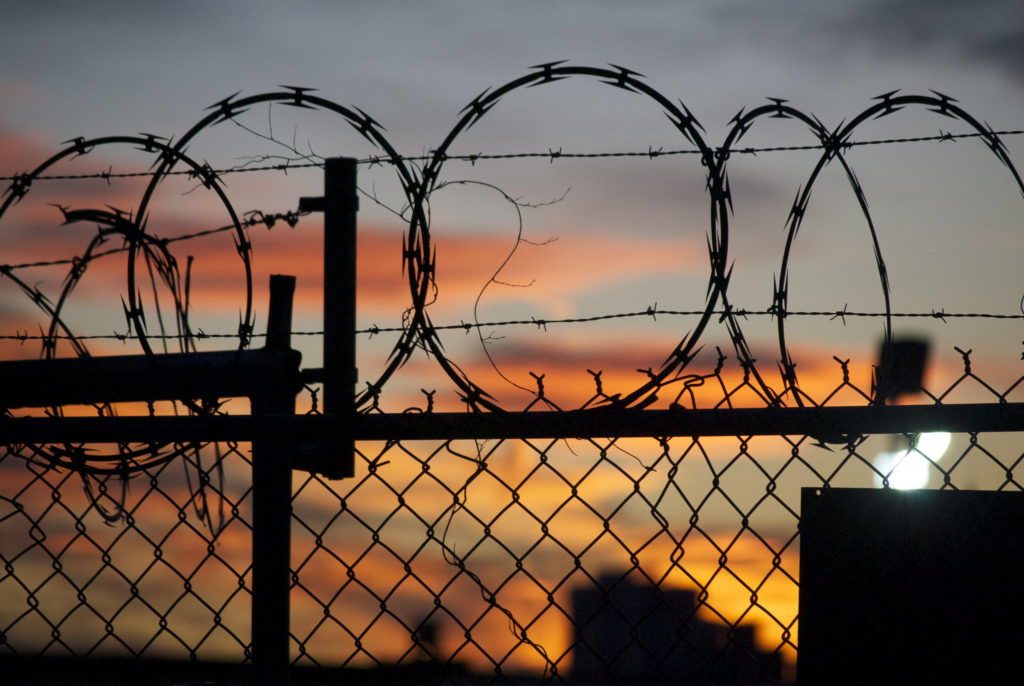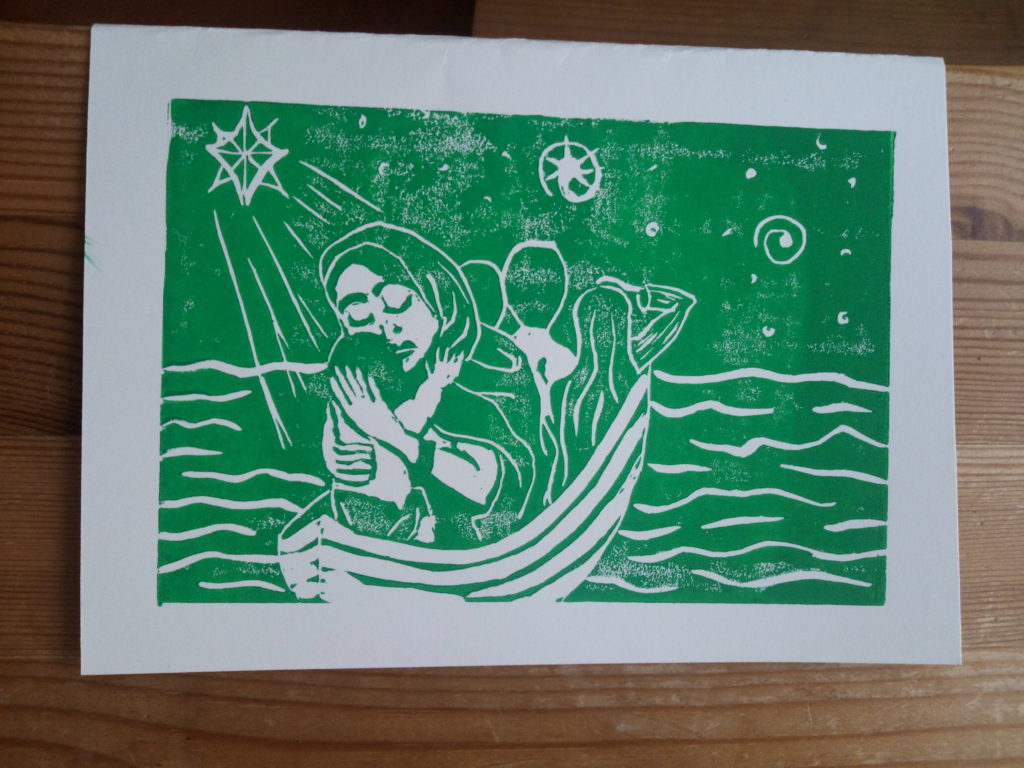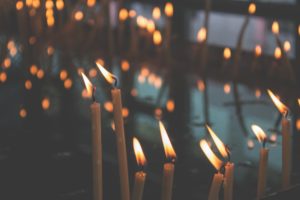
Category: refugees
Prisons of Our Own Making: Fear in the Age of the Refugee
During the season of Lent this year, as we lament the ways that both we and the world in in which we live are broken, my church community is particularly focusing on the theme of imprisonment, the liberating power of Christ, and the places where we long to see that freedom break through.
Celine Chuang, another writer in our community, put together a beautiful booklet of readings for each day of the season, inviting us to use poetry, prose, and visual art to engage with the question, “What prisons – whether literal, spiritual, physical, or structural – are present in our world today: in our city, country, society, and in ourselves?” In this booklet, familiar voices from our own neighborhood find their way onto the page alongside those of theologians, activists, and artists from around the world, exploring what it means to “acknowledge and lament imprisonment” and to “posture ourselves towards and participate in liberation from these forms of captivity.”
The first step to getting somewhere is knowing where you want to go. And so as we seek to live into the vision of God’s Kingdom on earth, we are trying to imagine together: “What does freedom from prisons look like?”
The poem below was my attempt to name some of the prisons I see around me and to envision a life beyond them.
Prisons of Our Own Making: Fear in the Age of the Refugee
We
imprisoned by narratives of fear
and scarcity
label the other as
Terrorist;
Illegal:
taker of lives,
taker of jobs,
taking away our homogeneity
and sense of security.
We call our prison a fortress,
believing it is we
who have prevailed over
the chaos outside,
and not our own fear
that has won by
relegating our existence
to captivity and isolation.
And they—
those from whom
we have separated from ourselves
by language
by place of origin
by passport stamp–
or lack thereof–
they
are imprisoned, too.
But their cells are not
the walls of their own imagining.
They are the real cement and iron
of immigration detention centres
turning profit
by the bed
by the day,
punishing the audacity
of those who have the nerve to
cross politically imagined lines in the sand
and seek opportunity
seek safety
seek survival.
What would it be
if we could look them in the eye
and see
not outsider
or villain
or poster child
or political symbol
or threat to our way of life,
but a reflection
of ourselves?
A spark of the Divine;
a life that’s on the line.
A human being
who belongs,
and who longs
to be free?
No Room
The weather in Vancouver has been cold recently. This morning is was -3 degrees Celsius outside, and frigid enough inside our apartment to see our breath as we looked out at the bare arms of the trees with the snowcapped mountains of the North Shore rising behind them.
We are drawing near to the end of Advent: the season of light; of hope and expectation–but also of longing. We are celebrating Christ’s entry into the world, remembering his humble, vulnerable entry into solidarity with his own creation as an infant. We retell the story of his undignified birth as an outsider in a city where few people were ready to welcome him. Perhaps, with the benefit of 2,000 years’ worth of hindsight, we imagine ourselves in the company of the shepherds, who heard and believed, or of the wise men, who recognized a king in the form of an ordinary village child and came to pay their respects. I’ve heard this story since I was a child myself, and instinctively I’ve always placed myself in the camp of those who were ready to welcome Jesus into the world.
But then again, all through this Advent season I have walked up and down the streets of my neighborhood past trees and houses strung with twinkling lights, and past homeless men and runaway youth who huddle under sleeping bags or sit collecting change in paper cups, the damp cold of the sidewalk seeping into their bones. This, while tens of thousands of homes sit empty across our city, offering passive income to investors rather than shelter to people who need it.
I follow the news about Rohingya refugees who are being raped, burned alive inside their own homes, and hacked apart with machetes. Some live through horrible violence, and–after fleeing with their elderly grandparents and newborn babies in tow–cross the border to the relative safety of Bangladesh to be turned back to the hell they have just fled by border guards who are “just doing their job.”
I read about the fear and suspicion running so rampant in the country of my birth that the nation as a whole is turning its back on refugees, slashing the number of people who will be resettled annually by more than half and passing laws to keep people from many parts of the world out of the country all together.
I look around and I realize that we still live in a world where there is often no room for the vulnerable members of our society who represent Christ in our midst. We still live in a world where Jesus is often met with the cold dismissal: No room.
So as I prepare to celebrate Christ’s coming on Christmas day, I think long and hard about how I can make room for Christ in the middle of the cold winter we find ourselves in right now, and how we as a society can extend welcome to Him in all of His distressing disguises.
Prayers for the deported
Today, The Mudroom has published an essay I wrote about the grief of journeying alongside refugee claimants who are denied asylum, and the ways that my coworkers and I have learned to care for our souls so that we can continue to reach out to new arrivals despite the recurring pain of having friends deported. Here’s how it starts:
Silently, we sit around in a circle as my co-worker picks up the first candle, speaking a name and a prayer as she lights the wick and sets the tiny flame down in the middle of the table. We each follow suit, one prayer and tongue of fire after another.
God, we don’t know where they are or if they’re alive…
Please keep her safe…
Please provide whatever he needs…
Just don’t let them be alone….
May she know that she is loved.
Each candle on the table represents a friend who has been deported. Each prayer is for a family or an individual we have accompanied through the process of making a refugee claim in Canada. These people have all failed to secure the protection they have asked for, often because their story was not believed…
You can read the rest of the piece over at the The Mudroom. If you are someone who works with/lives alongside marginalized communities facing frequent violence or loss, what are the ways that you have learned to tend your soul in such a way that you are able to continue loving and reaching out without succumbing to burnout, hopelessness, or compassion fatigue? How can we strengthen ourselves to live as friends and allies with the oppressed over the long haul? I’d love to hear from you.
Two Canadas
Every week, our community gathers for a shared meal. We are made up of staff, volunteers, newly-arrived refugee claimant families living in community with one another in the share space of the welcome houses, and families who have already moved out and are in various stages of establishing themselves in Canada. Someone volunteers to cook, and we indulge in Kurdish or Afghan or Congolese food, getting to know each other a bit better by experiencing the smells and flavors that the cooks for that week have grown up with.
It’s getting late on a Tuesday night, and the crowd is thinning out. My friend has come to community dinner after an early morning and a long day at work, but he stays to wash dishes anyway. As we stand together at the sink, scrubbing and rinsing the plates and glasses, I ask him how work is going. He works in the most impoverished part of Vancouver, known locally as the Downtown East Side. This diverse neighborhood is home to some vibrant and inspiring communities, full of people whose stories of creativity and resilience would take your breath away. Paradoxically, it is also a place where issues of drug addiction, homelessness, and street prostitution are concentrated and contained in the middle of what is otherwise known as one of the “most livable” cities in the world. It’s the same neighborhood where Andy and I lived with the Servants community for six months when we first arrived in Canada, and it’s currently the epicenter of BC’s fentanyl crisis.
Fentanyl is an opioid 100 times stronger than morphine, and it has become so common in the street drugs sold and consumed in the Downtown East Side that 80% of the street drugs tested in a recent study were laced with it. This means that on a daily basis, the desperate people turning to drugs to cope with their pain and trauma—such as sexually exploited women, abused foster children who have aged out of care, and people with chronic, untreated mental illness—are now at higher risk of losing their lives, because the same dosage of heroin, cocaine, or crystal meth that would have merely provided a short period of euphoric escape in the past is now likely to deal a death blow. Overdose deaths are nothing new in Vancouver, but the result of fentanyl’s proliferation has been such a sharp increase in overdose deaths across BC (922 in 2016 alone) that our provincial health officer has declared a public health emergency, and the province has urged the federal government to do the same.
My friend’s job has made the crisis personal. He’s been trained to use Narcan, an opiate antidote that works as an emergency treatment for overdoses by blocking the effects of opiates on the brain. During one of his shifts, he found a man in the street who had overdosed on an opiate laced with fentanyl, and he saved the man’s life by injecting him with naloxone and waiting with him until an ambulance arrived.
My friend tells me about the sense of fulfillment he gets from being part of a community at work that is building people up, and the happiness he feels in seeing people make progress in their lives as a result of the care and respect they’ve been shown. He reflects on the anger he feels about the government’s complacency in responding to the fentanyl crisis, and the way that the down-and-out people he sees in the neighborhood are robbed of their dignity in a million different ways on a daily basis. He even reflects on the similarity between the indifference of the wealthier people he sees interacting with homeless people in the Downtown East Side, and the privileged obliviousness with which he once lived his life in his home country—before he lost everything, before his family sought asylum on the other side of the world, before they entered into temporary poverty and into the stressful process of waiting for The Powers That Be to decide their fate in a hearing room.
I am moved by my friend’s compassion; by the fact that instead of losing himself in anger or despair over the injustice that he himself is experiencing, he is instead choosing to throw himself into the hard work of confronting suffering, building relationships, and doing what he can to make the world a better place. My friend hails from a country that has been torn apart by war. He and his family were forced to flee their home under threat of death, and so far, they have experienced the refugee protection system here in Canada as an unresponsive bureaucracy that is yet to grant them protection or provide any promise of permanence or safety. (So much depends on the subjective assessment of the particular human being assigned to decide your case, the potential ignorance or inflexibility of the system, or how well or poorly your lawyer does their job…)
Yet instead of feeling self-pity, what my friend feels is a sense of righteous anger on behalf of all those who are unjustly suffering in our society. “You get very tired, but at the same time there is something pushing you,” he explains, speaking of his sense that God strengthens and inspires him to continue being present with people around him who are in difficult circumstances.
We discuss the idea that there are actually two Canadas: one inhabited by wealthy people who can choose to go about their lives without ever facing the brutal realities of poverty, addiction, and injustice in their country, and another inhabited by marginalized people like the ones my friend meets at work. He views the world of the Downtown East Side as the more honest one because the people he’s gotten to know there are so real. “There’s no fakeness,” he explains. “If I had to choose between the two,” my friend states with conviction, “I would choose to stay with those guys [in the Downtown East Side].”
Tears spring to my eyes as I realize that in the solidarity my Muslim friend describes, I am encountering the heart of Christ. I realize that, in the relatively brief time that he has lived in this country—with precarious status, no less—my friend has engaged more fully with Canadian society than the majority of people who have lived here their entire lives without ever having to justify their presence within these borders. I realize that this man’s life challenges me to embody the ideals that I myself profess but so easily fall short of living out. My friend is a refugee, but that label doesn’t even come close to capturing who he really is.
I pray for the day when my friend’s family will be allowed to officially call this place home, the day the beauty of their lives and contributions will be recognized and welcomed, and the day that my friend’s longings for justice will be fulfilled.
Resisting a single story
Recently, at the nonprofit office where I work , a new volunteer came in to help members of our community look for their first jobs in Canada. As we debriefed at the end of the day, she expressed surprise about the level of skill and competence shown by the people she had met. She was impressed by their high level of education and professional experience, and she told me that she hadn’t expected refugees to be like that. “Someone should write about this,” she told me. “People don’t know this about refugees.”
I am grateful that this volunteer had the chance to encounter people seeking refuge in Canada face-to-face, and that she allowed the experience to challenge the stories of refugees she had encountered up to that point. Her surprise alludes to one of the narratives I often hear repeated about refugees in popular culture these days: that they are helpless, passive recipients of charity. This narrative has no doubt motivated a large number of people to help because it tugs on heart strings, but such a one-dimensional story is dehumanizing nonetheless. Though it is true that refugee newcomers have survived trauma and tragedy and are in need of assistance as they begin the process of rebuilding their lives in a new country, they are not merely the victims of the worst thing that has ever happened to them. The people I know who are living the refugee experience are protagonists in their own stories; often, they were forced to flee their home countries in the first place because of courageous decisions to stand up for what they believe in, to defend the rights of others, or to be themselves in hostile places that demand conformity.
But beyond negating an individual’s agency in his or her own life, the “charity case” stereotype of refugees plays into the very destructive and misleading idea that we need to be careful about how many of these needy people we let into our country. According to this narrative, we could easily be swamped with people who will be a drain on resources and drag us all down by taking more than they contribute. Following this logic, we can begin to see refugees–or people in poverty generally–as a problem to be solved.
Yet I have discovered firsthand just how far from reality this story really is. The refugees in my life are medical doctors, diplomats, poets, human rights activists, engineers, journalists, and business people. They are children who arrive with no English and become fluent in a matter of months just by overhearing adults’ conversations or being thrown into a classroom where no one else speaks their language. Or they are housewives who never even had the chance to attend school in their home countries, but who are now eager to enroll in high school completion programs, learn language and culture, and start their careers.
The refugees I know are loving parents, loyal friends, socially engaged people who are eager to volunteer and give back to their communities. Basically, they’re the kind of neighbors that any of us would be lucky to live next door to, and the kind of people we should be welcoming into our nations with open arms—not only because it is the right thing to protect people who are vulnerable, but because of the amazing contributions these individuals will make to our society. Seeing all the creativity and energy my friends bring with them and all that they offer to our community, I am unable to reconcile my experience of them with the fear-mongering rhetoric of scarcity that tells us there are “too many” coming, or not enough resources to go around.
In her TED talk entitled, “The Danger of a Single Story,” Nigerian-born writer Chimamanda Adichie explains how the use of a single story to represent an entire nation or group ultimately “robs people of dignity. It makes makes our recognition of our equal humanity difficult” because “it emphasizes how we are different rather than how we are similar.” When Adichie discusses the complexity of her own childhood, touching both the happiness of her family and the fear of living under the rule of a military junta, she tells her audience, “All of these stories make me who I am. But to insist on only [the] negative stories is to flatten my experience and to overlook the many other stories that formed me. The single story creates stereotypes, and the problem with stereotypes is not that they are untrue, but that they are incomplete.”
So let’s spend more time getting to know as many stories as we can: the stories that have formed us, and the stories that have formed the people we think we already know. The next time you hear a single story flattening refugees or any other group into cardboard cut-outs of who they really are, think of the magnificent, multi-dimensional human beings I’ve just described, and challenge the narrative.
My guess is that the more stories we are able to hold at the same time about the same person or group of people, the less we will be able to draw firm lines between “us” and “them,” between who is “good” and who is “bad,” or between who belongs and who doesn’t. The more fluid our categories become, the more we will recognize pieces of ourselves in each other, and the more we will be both humbled and awed by what we see.



